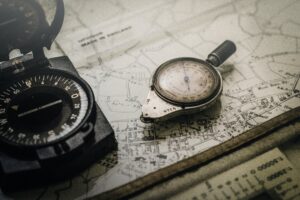Use of maps and compasses
during treasure hunts
On your outdoor treasure hunt, understanding how to use maps and compasses is essential to guiding you to the clues and getting you closer to your goal. Learning the basics of map reading and compass navigation will help you get around in the great outdoors.
In this article, we’ll explore the key elements you need to know to use maps and compasses on your treasure hunt. You’ll discover how to interpret the information provided by the map, recognise topographical symbols, and navigate your way along trails relying on the compass to reach your destination.

1. Understanding the basics of map reading:
When preparing for an outdoor treasure hunt, it’s important to understand the basics of map reading to help you navigate your quest. Here’s what you need to know:
- Scales and distance : The scale on the map helps you to estimate actual distances on the ground. The greater the distance on the map, the greater the actual distance, and vice versa. Use this scale to estimate the distance between the various landmarks you are looking for and to plan your route accordingly.
- Topographical symbols: On the map, you’ll find various symbols representing features such as rivers, roads, buildings and hills. Learn to recognise these symbols, as they will help you identify key features of the terrain during your adventure. For example, the contour lines will show you any steep areas or gentle slopes you may encounter.
- Contour lines: Contour lines show changes in height on the map. Curves that are closer together represent steep terrain, while curves that are further apart indicate flatter terrain. By understanding these contours, you can choose easier routes and avoid difficult areas.
- Map legend: The legend is your guide to understanding what the different symbols on the map represent. You’ll find valuable information about what the symbols mean and what they represent in the real world. Take the time to consult the legend to interpret the map correctly and identify the landmarks mentioned in the puzzles.
By understanding these basics of map reading, you’ll be better equipped to navigate successfully throughout your adventure. Don’t hesitate to study the map in detail before you start, and don’t forget to keep a close eye on the key features of the terrain to help you achieve your goal!
2. Learn the principles of compass navigation:
When you embark on an outdoor treasure hunt, a compass can be your best ally in helping you find your way. Here are some basic principles you need to know to use a compass effectively:
- The cardinal points : The compass shows you the four cardinal points: north, south, east and west. North is particularly important as it gives you the reference direction for travelling in other directions.
- Finding degrees: On the compass, you’ll see a scale graduated in degrees from 0 to 360. By using the degrees, you can determine the precise direction in which you need to move to find your next clue.
- Using the direction lines: The direction lines on the compass help you keep your heading in the right direction. When you’re walking, keep an eye on the direction line corresponding to your desired heading to make sure you’re following the right path. This will help you avoid getting lost and stay on track.
- Practice navigation: Before you start your treasure hunt, take the time to familiarise yourself with your compass. Practise taking bearings and navigating in familiar areas so that you feel more comfortable using it. The more you practise, the more confident you’ll be in your ability to navigate.
By understanding these basic principles of compass navigation, you’ll be able to get around with ease during your adventure. Don’t forget to keep your compass close at hand and check its orientation regularly to make sure you’re heading in the right direction.
3. Plan an efficient route based on map indications :
When you set off on your treasure hunt, it’s vital to plan an efficient route based on the indications provided by the map. Here’s how to do it:
- Choose clear landmarks: Identify distinct landmarks on the map, such as rivers, lakes, hilltops or buildings, to help you plot a clear and precise path to your next destination. By choosing obvious landmarks, you’ll reduce the risk of getting lost along the way.
- Plot a simple, direct route: Use the information on the map to plot a simple, direct route between the landmarks you have chosen. Avoid unnecessary detours or complicated routes that could waste time and energy. Keep your route as simple as possible to achieve your goals quickly.
- Anticipate potential obstacles: Take into account potential obstacles such as dense woodland, rivers or steep slopes that you may encounter along the way. By anticipating these obstacles, you can adjust your route accordingly and choose more practicable paths to avoid unnecessary difficulties.
- Keep an eye on your progress: As you follow your route, keep a close eye on your progress in relation to the landmarks shown on the map. Check your position regularly to make sure you’re on the right track. If you notice any deviations from your planned route, take the necessary steps to refocus and get back on track.
Keep your itinerary simple and efficient to maximise your time and energy during your adventure.
4. Use the compass to adjust direction to suit the terrain :
When you’re venturing out into the wild, using a compass can make navigating much easier. Here’s how to use it effectively, depending on the terrain you encounter:
- Locating the points of the compass: As mentioned above, the compass shows you the points of the compass – north, south, east and west. Use these to steer you in the right direction for your planned route. Keep an eye on the compass to make sure you’re heading in the right direction.
- Adjust your direction to take account of obstacles: Along the way, you may come across various obstacles such as hills, valleys or watercourses. Use the compass to adjust your direction to take account of these obstacles. If you come across a hill, for example, make sure you take its gradient into account by adjusting your direction to climb the hill safely and efficiently.
- Follow the direction lines: On the compass, you will see direction lines that indicate the path to follow to reach a specific point. Use these lines as a guide to stay on track and make sure you progress towards your next checkpoint or final destination. Keep a close eye on the compass so you don’t stray from your intended path.
- Adapting to changes in terrain: Nature can throw up surprises with sudden changes in terrain. Be prepared to adjust your direction to take account of these changes. If you come across a deep valley, for example, make sure you take its presence into account by adjusting your route to get around the obstacle safely and efficiently.
By understanding the basics of map reading, you’ll have the essential skills to find your way around and guide you on your adventure. Using this knowledge, you’ll be able to decipher the map, identify key landmarks and plan your route efficiently, bringing you closer to the treasure.

